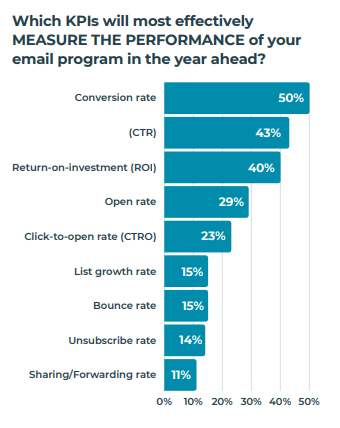Great email marketing campaigns don’t start with a killer subject line or a compelling call to action. Instead, they begin with an objective. The fact is, if your email marketing strategy doesn’t have an objective, you’ll never know if it’s been successful or not.
When you set those objectives, you’ll need something to measure them against accurately. Even if you already consider your email marketing campaigns successful, anecdotal evidence isn’t good enough to justify the time and money you are investing in any marketing strategy. If you are looking for further investment in marketing resources or improved technology, you’ll need something more solid to base this investment on. This is where Key Performance Indicators (KPIs) come into play.
Setting Key Performance Indicators (KPIs) tied to your marketing objectives will help you and your management team better understand your performance. For example, if you fall short of your objectives, they will help you adopt the strategies to improve your email engagement (testing, list hygiene, list growth, etc.). Conversely, if you are smashing your goals, they will help you do even better (testing, list hygiene, list growth, etc.).
Email Marketing KPIs—Moving Metrics
Like everything else in email marketing, the KPIs used to measure your success are in a constant state of flux.
For example, if you’ve previously looked at open rates as a sign of success, Apple’s recent iOS 15 Mail Privacy Protection update will have definitely skewed your results.
So what KPIs should the modern marketer look to when measuring their email marketing success? We posed this question to our community of B2B marketers when compiling our annual State of Email Marketing Report.
Conversion is King
Perhaps unsurprisingly, in this post-pandemic age, many email marketers’ attention is largely focused on metrics that actively help them achieve their objectives rather than vanity metrics.
Half of all marketers said they considered conversion as the most important KPI to measure their performance effectively. It’s important to remember conversion doesn’t necessarily mean money in the bank through sales (although that always helps). Conversions could also include downloads of detailed product information or thought leadership content, video or podcast plays, or registrations for webinars and other online events.
Therefore, a conversion is simply the best possible outcome for a particular campaign based on your objectives.

Following conversions, Click-Through Rates (CTR) and Return-On-Investment (ROI) come a close second and third, with 43% and 40% of marketers highlighting their importance as effective KPIs to measure.
Are Businesses Finally Getting Serious About Email Marketing?
It could be argued that email marketers are finally being taken seriously by focusing on KPIs that deliver on real objectives, rather than just anecdotal, “nice-to-have” metrics. Of course, email marketing has always been a legitimate business accelerant, but it has taken the sudden shock of the global pandemic for many organizations to really appreciate its value.
At a time of continued business uncertainty, cash in the bank is essential. Now is perhaps not the time to experiment with high-risk acquisition marketing strategies. Email marketing with its associated low costs and reputation for generating the highest ROI of any marketing strategy available to today’s marketers is suddenly very attractive.
This assumption is good news for email marketers. When the wider organization is focused on the potential of email, the opportunity to invest in more resources and increasingly powerful technology becomes a reality.
Email List Growth—Sound the Alarm
However, our research also reveals some interesting data, which we, quite frankly, find a little worrying.
Only 15% of marketers consider email marketing list growth as an effective KPI to measure the success of their campaign strategy.
While this might be a reflection of the shift from high-cost acquisition marketing to low-cost retention marketing to weather the uncertain business environment, it isn’t a long-term strategy.
If your analytics are telling you that your conversions, CTRs, or ROI are in decline, it might not be a reflection of your campaign quality. Instead, your lists might just be getting a little bit fatigued or just plain worn out.
The fact is, many email marketing addresses have a limited shelf-life. The average age of an email address is only 18 months. People change jobs, service providers, and, sadly, nobody is immortal. A “dead” email address will only ever deliver bounces.
Therefore, email marketers must factor in list growth activities as part of their ongoing email marketing strategy. While budgets for acquisition might still be restrained, there remain incredible opportunities in social media marketing and content marketing to maintain well-stocked and highly engaged email lists.
Email Marketing Analytics—Act Now!
As email marketers, we are probably all guilty of sending campaigns, jumping into our analytics, and immediately celebrating our successes or leaving disappointed. If this is as far as your use of email analytics go, email marketing success or failure will always be something of a dark art.
Setting KPIs and carefully monitoring your email marketing analytics to measure your success against them is only helpful if you act on the information. This means taking the time to understand why some campaigns work and others don’t. Testing is a significant part of this strategy.
KPIs make us more accountable and visible, and as email marketers who understand the importance of the medium, this should be welcomed.
Need help setting your KPIs and measuring your success against them? Contact us today at expert@emfluence.com.



